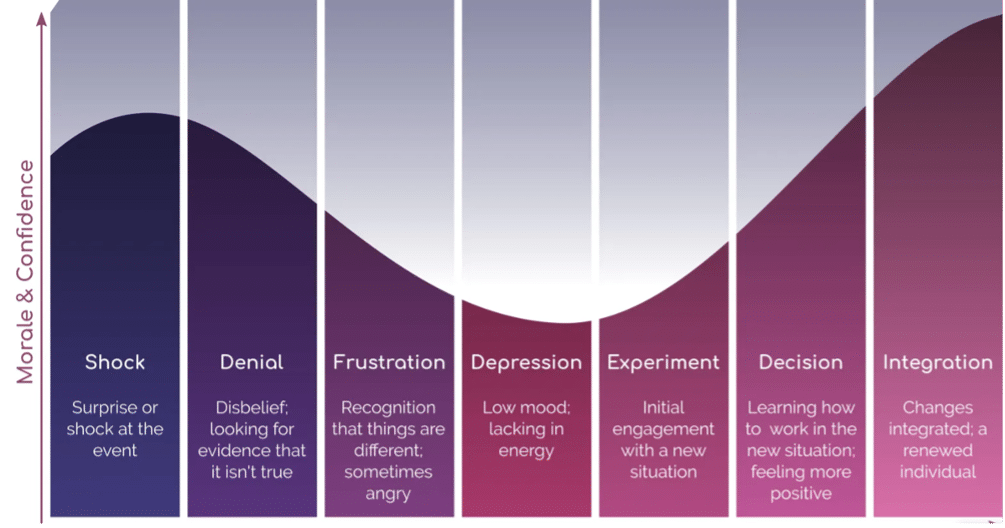Change Management: The Proven Winner for MarTech Implementation Success
For many companies, there are three general approaches to MarTech investments: try to crack a nut with a sledgehammer (overinvest), bring a knife to a gunfight (underinvest), or attempt to get by with legacy solutions, even though they cost more, do less, and don’t set the stage for modern work management. But regardless of how a company approaches their marketing technology, the true secret weapon for success is not about how much or little technology you buy, it’s about putting people first.
As a Chief Learning Officer, I often see the inflated expectation of what tools can achieve on their own. The risk of failure for new tech initiatives remains so high (an alarming 70 – 95%) because companies wait too long to factor in the people, processes, and systems that make technology work; leaving CEOs and leaders holding the bag for investments that were doomed to fail from the start.
Solely amping up the technology training budget is not the answer, either. There is a huge difference between teaching an employee how to use new technology and getting them excited about why using it will matter to them (and in turn, your customers, and the business).
The key to getting individuals and teams aligned and adopting new technology investments is change management. And it needs to come first. We are all human, and we all react differently to change. Our understanding of how change impacts us individually, and by our work-related roles, will always differ. As organizational behavior expert Dr. Corrie Block, PhD, DBA writes in “12 Reasons your Digital Transformation will Fail,” humans are the problem and the solution.
At LeapPoint, we use the Prosci ADKAR® Model with our clients — a results-oriented approach to managing change based on a simple truth: company-wide change happens one person at a time. Providing a simple step-by-step approach, the ADKAR Model (awareness, desire, knowledge, ability, reinforcement) helps leaders and teams effectively manage individual change to achieve a desired outcome.
Change management is a proven winner for the adoption of any new technology or system. When we embed the Prosci ADKAR® Model into major digital transformations, 94% of the projects meet their objectives.
5 Ways to Use Change Management to Improve Success
From our experience serving some of the largest, most notable brands, here are the top 5 ways companies can use change management to increase the success of implementation and support the people using them.
- Put Change Management First, Not Last. While training and upskilling your people is part of putting people first, it does not consider the emotional, motivational, and cultural elements of change. An effective change management strategy takes these factors into consideration and will more effectively inform the type and style of technology training that will resonate with employees. Embedding change management into digital transformation projects at the beginning of a project is a key differentiator for successful implementations and increases the opportunities for success.
- Define The Why & The WIIFM. Change doesn’t trickle down on its own because an executive leader declares that everyone is going to adopt a new program or technology. If front-line staff and managers don’t understand why a change is needed, it won’t get implemented. If employees don’t get the WIIFM – what’s in it for me – they will resist. All employees need a view of the state of the organization from active change sponsors and leaders explaining why a change is needed and who is in charge of making it happen.
- Select and Support Change Sponsors. Most executives and managers do not intuitively know how to serve as effective sponsors of a change. They may not know how to promote a new project, encourage staff, or point employees in the right direction if they experience problems, because they may be having problems themselves. Companies that enable their change sponsors in the form of regular collaboration meetings and access to enterprise-wide leadership teams, experience the greatest (and fastest) success because they are supported and in it together.
- Communicate Early and Often. Effectively promoting a change is more than a blurb in the company newsletter or a note on a Slack channel. Change management needs to go deeper than that and include critical issues communicated early and often by change sponsors. Communication on a regular cadence from executive leaders and managers who are both active and visible, makes all the difference in the world.
- Expect and Serve the Curve. The Kübler-Ross Change Curve™ tells us that the first state of any change is initial shock. This goes for technology and process change too. Then comes denial, frustration that things are different, and then possibly, resistance. But then, there’s a flip and people get “agency,” or a feeling of power and control over the resources to fulfill their potential. When companies anticipate the Curve (rather than take a Pollyanna view that nothing will go wrong), they can better set expectations and invest in the resources and services to shepherd employees through each phase of the change process.

The 3-Phases to Successful Change Management
Whether our clients are implementing Adobe Workfront across one team or many, or consolidating multiple tools across their MarTech ecosystem, we approach every engagement with three key phases:
Phase 1 – Initiation. Discover the business requirements for the project and define the current and future state.
Phase 2 – Launch. Reveal the vision for change and incrementally activate the change management strategy and roadmap through all the core communications, trainings, feedback loops, and support systems.
Phase 3 – Stabilization. Focus on reinforcing positive outcomes and addressing the behaviors and processes that still need to change based on adoption rates, analytics, and employee feedback.
Conclusion
While many organizations think they can “go at it alone,” we see change management as essential to ensuring a positive ROI. Our team of consultants have sat where you sit, and have the experience and knowledge to help your people not only achieve a successful initial implementation, but also drive long-term adoption and engagement.

Erin Furrow, Chief Learning Officer



